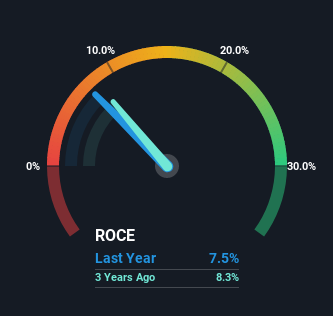The Returns On Capital At Aktieselskabet Schouw (CPH:SCHO) Don't Inspire Confidence

What trends should we look for it we want to identify stocks that can multiply in value over the long term? Typically, we'll want to notice a trend of growing return on capital employed (ROCE) and alongside that, an expanding base of capital employed. This shows us that it's a compounding machine, able to continually reinvest its earnings back into the business and generate higher returns. However, after briefly looking over the numbers, we don't think Aktieselskabet Schouw (CPH:SCHO) has the makings of a multi-bagger going forward, but let's have a look at why that may be.
What Is Return On Capital Employed (ROCE)?
For those that aren't sure what ROCE is, it measures the amount of pre-tax profits a company can generate from the capital employed in its business. The formula for this calculation on Aktieselskabet Schouw is:
Return on Capital Employed = Earnings Before Interest and Tax (EBIT) ÷ (Total Assets - Current Liabilities)
0.075 = kr.1.3b ÷ (kr.26b - kr.9.3b) (Based on the trailing twelve months to September 2022).
Thus, Aktieselskabet Schouw has an ROCE of 7.5%. On its own, that's a low figure but it's around the 8.6% average generated by the Food industry.
See our latest analysis for Aktieselskabet Schouw

In the above chart we have measured Aktieselskabet Schouw's prior ROCE against its prior performance, but the future is arguably more important. If you'd like to see what analysts are forecasting going forward, you should check out our free report for Aktieselskabet Schouw.
The Trend Of ROCE
In terms of Aktieselskabet Schouw's historical ROCE movements, the trend isn't fantastic. Over the last five years, returns on capital have decreased to 7.5% from 12% five years ago. Although, given both revenue and the amount of assets employed in the business have increased, it could suggest the company is investing in growth, and the extra capital has led to a short-term reduction in ROCE. And if the increased capital generates additional returns, the business, and thus shareholders, will benefit in the long run.
What We Can Learn From Aktieselskabet Schouw's ROCE
Even though returns on capital have fallen in the short term, we find it promising that revenue and capital employed have both increased for Aktieselskabet Schouw. However, total returns to shareholders over the last five years have been flat, which could indicate these growth trends potentially aren't accounted for yet by investors. So we think it'd be worthwhile to look further into this stock given the trends look encouraging.
One final note, you should learn about the 2 warning signs we've spotted with Aktieselskabet Schouw (including 1 which makes us a bit uncomfortable) .
For those who like to invest in solid companies, check out this free list of companies with solid balance sheets and high returns on equity.
New: Manage All Your Stock Portfolios in One Place
We've created the ultimate portfolio companion for stock investors, and it's free.
• Connect an unlimited number of Portfolios and see your total in one currency
• Be alerted to new Warning Signs or Risks via email or mobile
• Track the Fair Value of your stocks
Have feedback on this article? Concerned about the content? Get in touch with us directly. Alternatively, email editorial-team (at) simplywallst.com.
This article by Simply Wall St is general in nature. We provide commentary based on historical data and analyst forecasts only using an unbiased methodology and our articles are not intended to be financial advice. It does not constitute a recommendation to buy or sell any stock, and does not take account of your objectives, or your financial situation. We aim to bring you long-term focused analysis driven by fundamental data. Note that our analysis may not factor in the latest price-sensitive company announcements or qualitative material. Simply Wall St has no position in any stocks mentioned.
About CPSE:SCHO
Aktieselskabet Schouw
An industrial conglomerate, provides feed products used in aquaculture in Norway, Chile, Denmark, the United Kingdom, the United States, Ecuador, and internationally.
Undervalued established dividend payer.
Market Insights
Community Narratives



